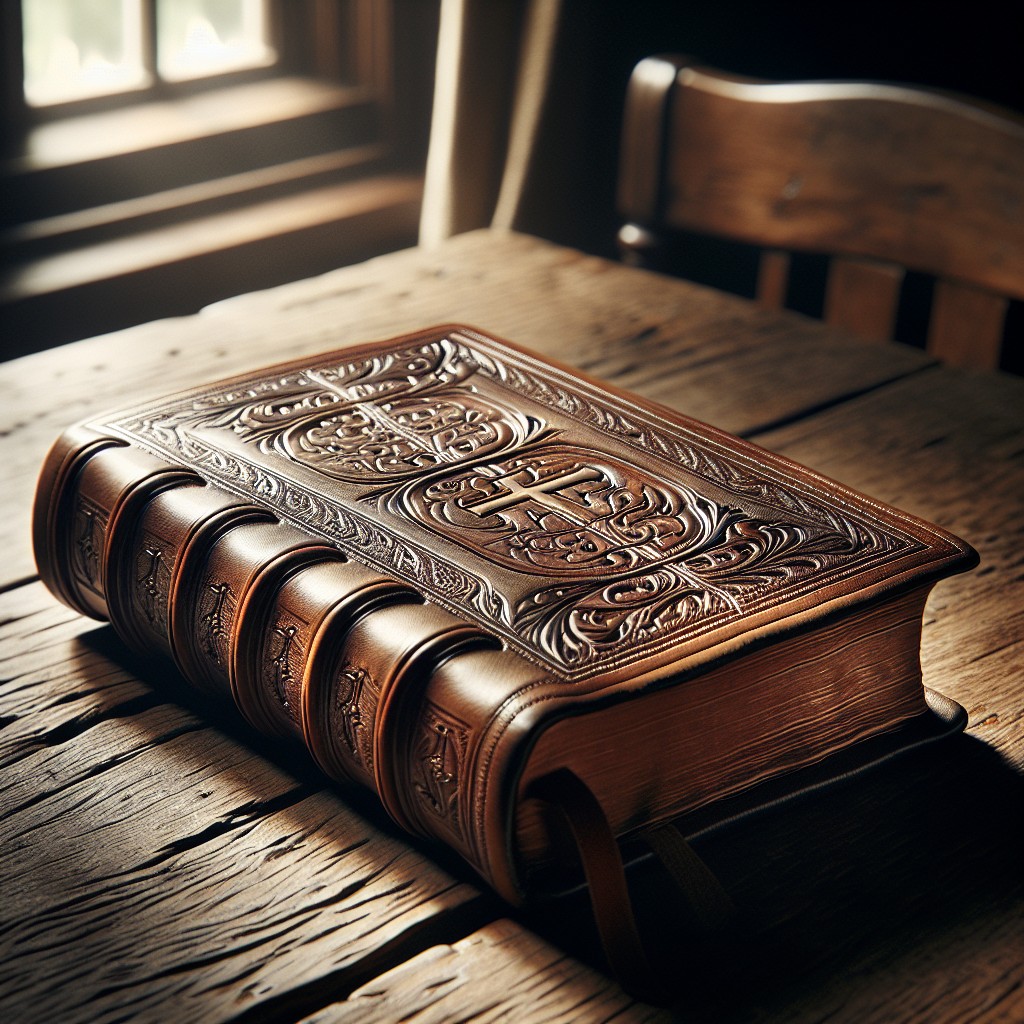Last updated on
Dive into the enriching world of Bible design because it can bring a new dimension to your spiritual journey, turning your reading experience into an artistic exploration.
The artistry and craftsmanship of Bible design serve as a testament to its sacred status, evolving through centuries of cultural shifts and technological breakthroughs. From intricately hand-copied manuscripts to the streamlined digital printing of today, the aesthetic and functional evolution of the Holy Scripture has always mirrored the zeitgeist.
In exploring the significant historical influence on Bible design, its modern trends toward minimalism, personalization, and eco-conscious materials, as well as the latest innovations that enhance both durability and user experience, we uncover the meticulous care invested in these cherished volumes.
Whether you’re intrigued by the visual feast of luxurious bindings or the practical advancements like lay-flat spines and digital interactivity, this article demystifies the convergence of tradition and innovation in Bible design.
Key takeaways:
- Historical Influence of Bible Design: Bible design has been shaped by history, reflecting various cultures and technological advancements.
- Evolution of Bible Craftsmanship: Bible production has evolved from hand-copied manuscripts to modern digital typesetting and printing techniques.
- Modern Bible Design Trends: Trends include minimalist aesthetics, personalization, portability, interactive features, and eco-friendly materials.
- Innovations in Durability and Functionality: Bibles now feature synthetic covers, lay-flat spines, QR codes, and thumb indexes for enhanced durability and functionality.
- Aesthetics of Bible Bindings: The choice of binding material, color, texture, and additional features contribute to the visual appeal and durability of a Bible.
Table of Contents
Historical Influence of Bible Design

Bible design has been deeply shaped by history, reflecting various cultures, materials availability, and technological advancements. Early manuscripts were painstakingly hand-copied onto parchment or papyrus by scribes. The introduction of the Gutenberg press in the 15th century revolutionized Bible production, making it more accessible to the masses.
During the Renaissance, illuminated manuscripts with intricate artwork became prominent, turning Bibles into both spiritual and artistic treasures. The Reformation era saw a shift toward simpler designs, aligning with the movement’s focus on scripture alone. Fast forward to the 19th century, the industrial revolution made mass production possible, leading to the widespread use of cheaper materials and bindings.
The early 20th century brought about the rise of pocket Bibles, designed for soldiers during World War I and II, prioritizing portability over ornate features. Today, historical design elements can still be found, with some editions borrowing from the rich decorative styles of the past, while others maintain the minimalist approach introduced during the Reformation.
Understanding the historical context of Bible design allows us to appreciate the visual and tactile diversity of modern Bibles and recognize the enduring influence of past craftsmanship on contemporary religious texts.
Evolution of Bible Craftsmanship

From the early handwritten manuscripts to the industrial print revolution, craftsmanship in Bible production has significantly evolved. Initially, owing to labor-intensive methods, a Bible was often a rare, ornate object, featuring lavish illustrations and embellishments. The introduction of the Gutenberg press in the 15th century revolutionized Bible manufacturing, making them more widely accessible. As printing technology advanced, so did the quality and variety of Bibles.
In the 19th and 20th centuries, mass production became the norm, and Bibles were often bound in plain, durable covers for everyday use. Concurrently, fine editions continued to be produced, often bound in leather with gold leaf pages and intricate embossing, targeting collectors and those seeking heirloom-quality pieces.
Today, precision and artisanship are blended through digital typesetting and modern printing techniques, allowing for high-quality, readable text, while laser cutting and engraving technologies contribute to more exquisite and personalized designs. The continued pursuit of durability has also led to synthetic covers and papers that withstand frequent handling and adverse conditions. As a result, Bible craftsmanship now spans the spectrum from practical, sturdy editions to beautifully crafted works of art, reflecting both advances in manufacturing and diverse consumer preferences.
Modern Bible Design Trends
As trends evolve, contemporary Bible designs reflect a blend of practicality and personal expression. One notable trend is minimalist aesthetics, with clean lines and understated covers gaining popularity. This style appeals to a modern audience seeking both simplicity and elegance.
Another trend focuses on personalization. Custom engraving, choice of colors, and even bespoke illustrations allow individuals to have a Bible that feels uniquely theirs. This personal touch creates a deeper connection between the text and the reader.
In terms of functionality, there’s been a shift towards portability. Compact, lightweight editions are designed for on-the-go individuals, ensuring that spiritual guidance is always at hand without the burden of a heavy tome.
Interactive Bibles with journaling space have also become popular, combining scriptural study with personal reflection. These editions often include wider margins and high-quality paper to accommodate notes and drawings.
Finally, eco-friendly materials are increasingly in demand. Recycled paper and sustainably sourced covers cater not only to environmental concerns but also to consumers seeking an ethically produced Bible.
Each of these trends illustrates a broader desire for Bibles that aren’t just religious texts but also lifestyle companions—integrating faith, function, and personal style.
Innovations in Durability and Functionality
Bibles today aren’t just spiritual tomes; they are marvels of engineering designed to withstand the rigors of daily study and travel. With the integration of synthetic covers such as Tyndale’s Tecarta, these sacred texts resist wear and tear, offering a sturdy companion for the devout.
Book block binding technology has leaped forward too, showing off smyth-sewn spines. This method, entailing the stitching together of book signatures, grants a Bible longevity and the ability to lay flat, facilitating easier reading and note-taking.
Yet, it isn’t only about robustness. Functionality goes hand in hand with durability. Some editions now feature QR codes that provide access to additional online resources, bridging the analog and digital realms of scriptural study. Margins are designed wider for a reason – to make space for reflections, insights, and personal notes.
Meanwhile, a growth in the popularity of indexing has seen thumb indexes become commonplace, guiding readers swiftly to the desired book or chapter.
From the paper selection to the cover material, every choice is carefully tailored to ensure that the Bible is not just a lasting artifact, but also a practical tool for both lay readers and theologians alike.
Aesthetics of Bible Bindings
The choice of binding for a Bible adds both to its visual appeal and its physical longevity. Leather, with its classic look and durable nature, remains a preferred material for high-end editions. Bonded leather or synthetic covers offer a cost-effective alternative, capturing a similar aesthetic.
For an artistic touch, some editions feature engraved or embossed designs, often including symbolic imagery or scripture verses.
Color also plays a vital role in binding aesthetics. From sober black or brown to vibrant hues, the color of a Bible can reflect personal taste or liturgical significance. Contrast stitching along the edges provides a subtle yet sophisticated detail that enhances the overall design.
Beyond the look, the binding’s texture can evoke a sensory experience. Soft-touch materials or supple goatskin covers provide a tactile sensation that enriches the act of reading.
Finally, practical enhancements such as thumb-indexing or gilded edges offer both function and flair. These design elements are not only about utility but also contribute to the Bible’s decorative character.
Typography and Readability in Bible Layouts
Selecting the right typeface for a Bible isn’t just about aesthetics—it’s crucial for readability. Serif fonts, such as Times New Roman and Garamond, are often chosen for their ease of reading in printed long-form texts. These fonts help guide the eye along lines of text, reducing strain during extended reading sessions.
Font size also plays a pivotal role. A point size of 9 to 11 is typically used to balance clarity and the amount of text on a page. Smaller fonts may allow for a more compact Bible, but can lead to eye fatigue.
Line spacing, or leading, helps to prevent crowding, allowing readers to track text more comfortably. An optimal leading is slightly larger than the point size of the font, allowing for a breathable text layout.
Margin width must accommodate note-taking without compromising the text block’s integrity. Adequate margins also contribute to the overall balance and aesthetics of the page.
Subheadings and verse numbers are usually set in a different weight or style to stand out from the body text, making navigation easier. Attention to these details promotes an enjoyable reading experience, aiding in the Bible’s role as a frequently consulted text.
Impact of Blog Advocacy On Bible Design
Blog advocacy has leveraged a sizable audience to influence Bible publishers and designers, effectively driving innovation and responsiveness to consumer preferences. Active blogger engagement has led to:
- Heightened Awareness: Bloggers dissect features with such precision that publishers are more cognizant of user experience, improving designs based on feedback.
- Niche Fulfillment: Advocates highlight gaps in the market, prompting the creation of Bibles catering to specialized interests or uses, such as journaling or study.
- Amplified Reader Voice: Blogs serve as platforms for collective input, where comments and discussion threads capture the public’s pulse on desired design elements.
- Elevated Design Standards: Competition among publishers intensifies as bloggers showcase high-quality Bibles, setting a benchmark for material and craftsmanship.
- Enhanced Accessibility: By underscoring the need for a variety of formats, advocacy aids in making Bibles accessible to a broader audience, including those with visual impairments.
These points illustrate the symbiotic relationship between bloggers and publishers, shaping the evolution of Bible design.
The Significance of Limp Bindings Description
Limp bindings, characterized by their flexible covers, offer both aesthetic charm and practical benefits. Originating in medieval times, this binding style is resurging in popularity due to its tactile appeal and user-friendly nature.
- Durability: Limp bindings are generally made with high-quality leathers or durable synthetic materials, allowing them to withstand regular use and travel better than hardcover bindings.
- Portability: The flexibility of a limp-bound Bible makes it more comfortable to hold and easier to pack into bags, making it the ideal choice for readers on the go.
- Aesthetic Varieties: From soft calfskin to synthetic leather, limp bindings offer a range of textures and colors, satisfying diverse tastes and preferences.
- Handcrafted Appeal: Many limp bindings are created by artisans, giving each Bible a unique, handcrafted touch that appeals to enthusiasts of traditional bookmaking.
- Longer Lifespan: When treated properly, the materials used for limp bindings can extend the life of the Bible, helping it to become an heirloom piece.
By embracing the old-world charm of limp bindings, contemporary Bible publishers are marrying tradition with modern-day needs.
The Reemergence of Reader’s Bibles
Inspired by the original format of scripture manuscripts, Reader’s Bibles prioritize an uninterrupted reading experience. These editions strip away the standard chapter and verse numbers, cross-references, and study notes that can clutter the page and distract from the narrative or poetic flow of the texts. The unencumbered layout mirrors that of a typical book, making it more approachable for extended reading sessions.
This design ethos acknowledges the importance of context and literary form in understanding biblical texts. It encourages readers to engage with larger portions of scripture, noting patterns and themes that may become obscure with more granular study approaches. In essence, it fosters a holistic immersion into the biblical world, inviting a fresh look at ancient texts that many find spiritually refreshing and insightful.
Reviewing Waterproof Bibles
Waterproof Bibles have emerged as a practical solution for avid outdoorsmen and readers on the go. Constructed from synthetic materials, these Bibles withstand the elements, resisting water, dirt, and oil. The pages, often made from a plastic-like substance, are durable and tear-resistant, allowing for usage in a variety of settings, from a rainy campsite to a sunny beach.
Not only do waterproof Bibles provide resilience, but they also maintain high levels of readability. Printing techniques have evolved to ensure that text does not smear or fade, even when damp. The lightweight nature of these Bibles adds to their appeal, making them easy to carry without the worry of damage often associated with traditional paper products.
When selecting a waterproof Bible, consider the binding quality and the ease of page turning. Some may have a stiffer feel to the pages, which can impact the reading experience. Additionally, assess the size and font for personal comfort, as legibility is paramount.
The practicality of waterproof Bibles introduces a level of versatility that traditional Bibles may not offer, granting readers the freedom to engage with spiritual texts in any environment without the fear of water damage.
Exploring the Quentel Series Innovations
The Quentel Series embodies a blend of traditional craftsmanship and modern design updates. Recognized for its generous margin space, this series facilitates improved readability and note-taking.
With a focus on typographic excellence, the series features a well-considered font size and leading, ensuring a pleasurable and strain-free reading experience. Another highlight is the line-matching across pages that minimizes text ‘ghosting’ and promotes a cleaner look.
Its paper is premium quality, opaque, and yet resilient, striking a balance between thickness and featherweight feel. Attention is also given to the binding which is often Smyth-sewn for durability and ease of opening.
These refinements illustrate a commitment to both aesthetic pleasure and functional utility, enhancing the timeless nature of the sacred text.
Rebinding and Personalizing Bibles
Rebinding a Bible breathes new life into a cherished volume, blending tradition with personal expression. This process involves replacing the original cover with new materials, often upgrading to premium leathers or alternative durable fabrics. Personalization adds a unique touch, with options including stamped names, meaningful dates, or custom imagery.
Beyond aesthetic enhancements, rebinding often improves functionality. A Bible may be fitted with a lay-flat binding, allowing for easier reading and note-taking. Hand-stitched methods ensure longevity, preparing your Bible to be passed down for generations.
When considering personalization, think about the following:
- Material Choice: Goatskin offers suppleness and durability, while calf or cowhide provides a sturdier option. Consider vegan alternatives as well for ethical preferences.
- Color Palette: Select colors that have personal significance or opt for classic hues that stand the test of time.
- Font and Imprinting: Choose fonts that match your style; gold and silver foil stamping add a luxurious finish.
- Additional Features: Ribbons, thumb indexes, and slipcases enhance both the look and the utility of the Bible.
Choosing a skilled binder is critical, as craftsmanship directly affects the end result. Research binders with experience in Bible work to ensure a respectful and appropriate treatment of the text.
Assessing Modern Bible Reprints and Facsimiles
The surge in demand for nostalgic or rare texts has prompted publishers to release facsimiles and reprints, allowing wider access to historic Bible editions. These modern renditions replicate the feel and appearance of the original works, extending an invitation to the past’s rich religious heritage.
To properly assess these books:
- Examine Print Quality: Check the sharpness and clarity of the text. Facsimiles should be free from blurring or smudging, honoring the integrity of the original print.
- Evaluate Cover and Binding: These should mirror the material and craftsmanship of historic counterparts. Consider the sturdiness of the binding and the authenticity of the cover material.
- Assess Paper Choice: The paper weight, texture, and color affect the reading experience. High-quality reprints often use cream or off-white paper to reduce glare and replicate the aesthetic of aged pages.
- Check for Additional Features: Some reprints include supplementary materials like original prefaces, maps, or annotations. These additions can enrich understanding and provide context.
- Compare Dimensional Accuracy: The dimensions of a facsimile should be consistent with its original edition. Size impacts handling and the overall reading experience.
- Investigate the Publisher’s Reputation: Select reputable publishers recognized for their dedication to accuracy and quality in reproductions.
- Recognize Modern Enhancements: While purists seek exact replicas, some reprints offer subtle improvements, such as better binding techniques or acid-free paper, to increase longevity without compromising the classic design.
These points offer benchmarks to consider when exploring the fascinating world of Bible reprints and facsimiles, ensuring both collectors and devotees make informed choices.
Comparative Review of Compact Bible Editions
Compact Bible editions serve a particular niche in the market, tailor-made for portability and ease of use. The pocket-sized companions are especially valuable for travelers, students, and those who frequent coffee shops for quiet reading.
Key aspects to assess when comparing these editions include:
- Text Size: Typically smaller to maintain a slim profile, it’s critical that the text remains legible to avoid straining the reader’s eyes.
- Binding Quality: Since these Bibles are often carried around, durable bindings are essential to withstand regular movement and potentially harsh handling.
- Paper Thickness: A balance between thinness (to reduce bulk) and opacity (to prevent bleed-through) ensures readability and a lightweight feel.
- Additional Features: Maps, references, and ribbon markers can enhance the study experience but may also add to the size of the Bible.
- Cover Material: Choices range from genuine leather to synthetic materials, affecting both the aesthetics and the durability of the Bible.
These compact editions represent a marriage of convenience and function without sacrificing the sacredness of the text, offering a diverse array of options to accommodate the preferences and needs of on-the-go readers.
Importance of Paper Quality in Bible Manufacturing
Selecting the right paper for a Bible is a critical decision that significantly affects its usability and longevity. Here’s what makes paper quality vital in Bible production:
- Opacity: A higher opacity minimizes show-through, enhancing readability as text from the other side of the page is less visible. Bibles often feature thin, opaque paper to accommodate their length.
- Thickness: While thicker paper is more durable and less prone to tearing, it can make a Bible bulky. Manufacturers must balance thickness with practicality.
- Texture: A smoother texture allows for easier page turning and less friction, especially important given the frequent handling of Bibles.
- Color: A slightly off-white or cream hue can reduce glare, easing the strain on readers’ eyes during extended periods of study.
- Acid-Free: Acid-free paper resists yellowing and deterioration over time, preserving the integrity of the text for generations.
By integrating these factors, manufacturers ensure that Bibles are not only a repository of spiritual guidance but also a pleasure to read and handle.
The Return to Traditional Wide Margin Bibles
Wide margin Bibles have garnered renewed interest for their practical and aesthetic benefits. The ample space surrounding the text allows for personal reflections, sermon notes, or artistic expressions directly next to relevant scriptures. This design caters to the needs of Bible journalers, scholars, and those who personalize their reading experience through annotation.
Wide margins also allow the Bible to lie flat when open, enhancing readability and study comfort. Additionally, this style preserves the traditional and timeless appeal of sacred texts, making them cherished heirlooms to be passed down through generations. The decision to revert to wider margins reflects a trend toward interactive and thoughtful engagement with the Bible, fostering a deeper connection between the reader and the divine word.
Writing and Notation Practices in Bibles
When it comes to the integration of personal notes and reflections, the design of a Bible plays a crucial role. Wide margins are often provided specifically for jotting down insights or referencing related scriptures, turning a Bible into both a holy text and a reflective journal. The quality of the paper determines how well it can handle ink without bleeding through or feathering, preserving the legibility of both the original text and personal annotations. Many avid readers favor acid-free papers that minimize yellowing over time, ensuring that notes remain clear for years to come.
Transparent adhesive sheets or Bible-safe highlighters are designed to avoid damaging the delicate pages while emphasizing key verses. Some editions even incorporate pre-lined or dotted areas catering to organized note-taking or creative expression through art such as Bible journaling. It’s clear that modern Bible design acknowledges the diverse ways individuals interact with scripture, providing a more customized and meaningful study experience.
Antique and Vintage Bible Restoration
Undertaking the restoration of an antique or vintage Bible requires a delicate balance; preserving the original charm while ensuring durability for continued use. Specialized techniques are employed to revive these treasured texts:
- Material Assessment: A thorough examination helps identify the type of leather, paper, and inks used, tailoring the restoration approach to these materials.
- Binding Repair: Often, the spine or cover suffers from wear. Restorers might reattach loose pages and reinforce the binding, respecting the original craftsmanship.
- Page Conservation: Acid-free treatments can halt further deterioration of the pages, while careful cleaning removes dirt and mold without damaging the fragile paper.
- Ink Preservation: Faded ink is stabilized to prevent further loss, ensuring the legibility of the text and the integrity of any hand-drawn illuminations.
- Aesthetic Touches: Restorers may use period-appropriate techniques to restore or replicate finishes, such as gilding on page edges or embossing on the cover.
Through these meticulous processes, the character of the Bible endures, ready for future generations to cherish and employ.
Consumer Demand Influencing Bible Design Evolution
As consumers voice their preferences, publishers have adapted Bible designs to meet these evolving desires. Features such as thumb indexing for easy navigation, soft-touch covers for a more tactile experience, and artistic embellishments appeal to modern aesthetics and practical needs. Larger fonts and ample margins cater to those seeking a more accessible and annotative reading experience.
Lightweight, thinner Bibles have become popular among individuals who carry their copies frequently, revealing a shift towards portability. Requests for environmentally friendly materials have also risen, leading to an increase in Bibles printed on recycled paper or produced using sustainable methods.
Personalization options have expanded, with buyers now having the ability to order custom engraved covers or select unique color combinations, turning the Bible into not just a religious text but also a reflection of personal style. The digital age has influenced physical design as well; QR codes for supplementary content and app integration prove that the traditional Bible can seamlessly integrate with modern technology to enhance the user’s experience.
Crossway’s Initiative On Reader-Focused Bibles
Crossway has been at the forefront of crafting reader-centric editions by prioritizing ease of understanding and comfort. The initiative centers around the ‘ESV Reader’s Bible‘ series, which eliminates all verse numbers, footnotes, and most section headings. This format echoes the original manuscripts, providing an uninterrupted reading experience akin to enjoying a classic novel.
In emphasizing readability, Crossway also considers typography. The fonts selected are larger and designed for readability, ensuring minimal eye strain during prolonged reading sessions. Margins are generous, allowing space for notes while also serving an aesthetic function, giving the text room to breathe.
Paper quality is another focus—opaque, cream-colored paper reduces glare, enhancing the overall reading experience. Crossway’s choice of paper also takes into consideration the bleed-through of ink, making the pages ideal for those who take notes or highlight passages.
The goal of these considerations is to cultivate deep engagement with the text, encouraging readers to immerse themselves in Scripture without the distractions of traditional Bible formatting. By emphasizing a clean and straightforward design, Crossway’s approach helps facilitate reflection and study.





